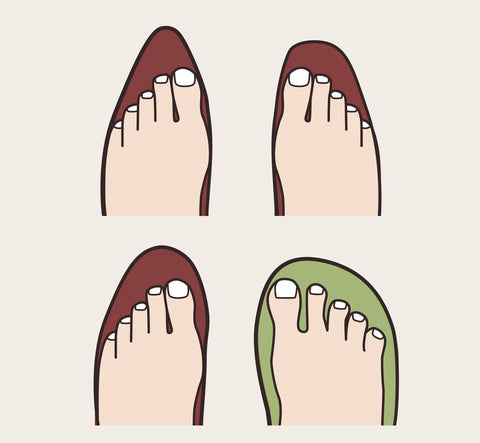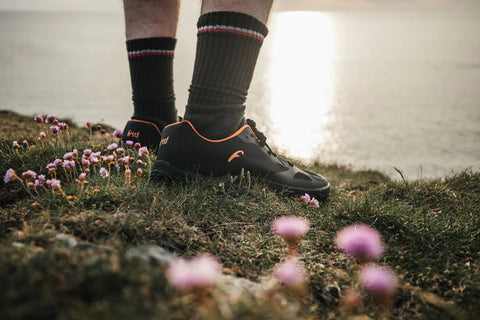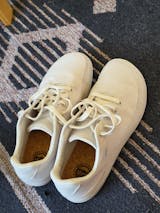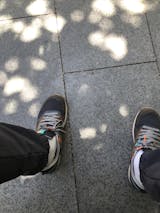So you’ve finally decided to switch to barefoot shoes after hearing all the rave reviews about them. Well, it’s safe to say that you’ve made the right decision, however, what you don’t want to do is make the wrong decisions when it comes to transitioning to barefoot footwear.
What we mean is that there are some crucial factors involved in making this transition from modern or conventional shoes to natural or minimalist footwear and, in order to do it successfully, one must know how to safely go about it. Even for those who have done their research, there may be some unanswered questions that are holding them back from beginning their journey to barefoot shoes.
With that, we feel compelled to share five important answers to five important questions you should ask before transitioning to natural footwear. Let’s begin!
#1 Will Barefoot Shoes Change My Foot Shape & Function?

Take a look at the current shape of your feet; it probably matches the shape of the type of shoes you’ve been wearing for most of your adult life, if not since childhood. You may notice your end toes pointing inward while your large toe joint juts out on the side (known as bunions). All of this is to say that wearing modern shoes over a long period of time leads to foot deformities and disorders that evidently change the shape of the foot, and hinder foot function. Fortunately, all hope is not lost because, with time, barefoot shoes can reverse the negative effects regular shoes have had on your feet.
Some of the most visible changes you will see after transitioning to barefoot shoes include:
- A healthy increase in toe splay. Your toes will spread out more as the metatarsals realign with time. Your foot may become slightly wider and, perhaps, a little longer due to its newfound freedom from tight and narrow footwear that squash the feet.
- This is completely natural and is not something anyone should worry about. In fact, sometimes, these changes are very insignificant and cannot be noticed just by looking at the foot. Moreover, barefoot shoes are made to support and accommodate this natural foot shape.
- On the other hand, those with flat feet may experience shortening of foot length due to the development of arches. This happens because the objective of barefoot shoes is to mimic being barefoot which, among many other benefits, works the muscles in the foot arches and forms them.
In addition to the visible changes, you will experience gradual improvements to the primary functions of the feet which include rigidity for bearing weight, flexibility to adapt to different surfaces or terrains, and mobility and strength to distribute weight evenly and provide balance.
#2 Can Anyone Wear Barefoot Shoes?
The short answer to this question is that anyone who has normal feet or simply does not suffer from certain types of foot problems and underlying chronic conditions that affect the feet or lower extremities can, in fact, wear barefoot shoes and enjoy the benefits they offer.
With that in mind, note that some individuals with foot deformities or disorders are advised to consult a professional for guidance on the best and safest way to transition to minimalist shoes. This is all the more crucial for anyone who has been diagnosed with the following:
- Peripheral neuropathy
- Deformities of the musculoskeletal system
- Ehlers Danlos Syndrome
On the other hand, if you have plantar fasciitis, bunions, hammertoes, or similar foot problems that are typically caused by wearing narrow, ill-fitting footwear, switching to barefoot shoes (gradually) can do you a world of good!
#3 Are Barefoot Shoes Suitable for Physical Activities Like Running, Hiking, etc?
While all barefoot shoes follow the same principles in design construction, some are made with specific intentions that cater to individual shoe categories such as running, walking, working out, hiking, casual wear, and even dress shoes. The many different styles available make it easy to replace your current collection of modern shoes with these healthy alternatives. In fact, minimalist hiking shoes and athletic shoes can boost your performance by training your feet to serve you better!
One should be reminded, however, that it is not advisable nor safe to suddenly go from wearing conventional footwear to natural shoes because they are so different. With the former, your feet are used to being overly cushioned, elevated off the ground with thick soles and heels, and snugly pushed into a pair of narrow toe boxes. As unhealthy as these factors are for your overall foot health, you cannot do away with them overnight; this needs to be done gradually instead. Therefore, while you will be spoiled for choice when it comes to selecting shoes for a specific purpose, you must first take the time to wear transitional footwear that will help you reach your end goal.
#4 How Can I Transition to Barefoot Shoes As a Beginner?
Transitioning to barefoot footwear is a process that takes time, and one that differs from person to person. How quickly your feet adapt to the changes will depend on how much time and effort you put into the entire process. This includes wearing transitional shoes or beginner barefoot shoes for short periods of time every day, incorporating foot exercises into your daily routine, and even walking barefoot in your home for as long as you feel comfortable.
The most important things to remember are to go about the changes gradually and consistently. Although our feet were made to be rigid and adapt to all kinds of terrains, having little to no direct contact with the ground over the years has made walking barefoot such a foreign and uncomfortable experience for so many people.
The goal is to bear some amount of discomfort (whether you are barefoot or wearing barefoot shoes) without pushing yourself to the point of pain. As you begin to get used to the changes, increase the amount of wear time over a couple of weeks or even months until you are comfortable with wearing them all the time. One great way to help your feet adapt, and to speed up the transition to some extent, is by strengthening and stretching your feet with foot exercises and mobility drills.
#5 How Do I Find the Best Barefoot Shoes for Me?
There are several shoe makers in the barefoot/natural footwear category, however, many individuals prefer some brands over others. The reasons behind this are typically limited to styles and fit. Therefore, finding suitable barefoot shoes for your unique feet is often achieved by trying out different brands to see what feels right to you and your foot shape.
Aside from that, one should also know what to look for in a shoe when transitioning to minimalist footwear. Here are a few tips that will be of help in that regard:
- Start with thicker yet flexible soles. True minimalist shoes feature thin soles that you can literally fold/roll with your hands, however, for a beginner to barefoot shoes, slightly thicker soles (with no heels) are advised during the transitional phase. Feet will need time to transition and adjust.
- Look for shoes that are widest at the toes. Simply put, if the toe box area appears to have a bullet or bunion shape, stay away from it! A wide toe box is a must!
- Avoid extra cushioning/padding. It may feel great, but all that softness is partly taking away your foot’s ability to develop into strong, resilient feet. When switching to barefoot shoes, however, it helps to start with footwear that has some amount of padding, just not as much as a regular pair of modern shoes.
- Choose lightweight shoes. Give your feet the break they deserve from heavy shoes that do no good for your feet and body.
- Seek Bprimal Professional Advice. When in doubt please reach out and discuss with the bprimal team about finding the right transitioning footwear for you. We'd be happy to help!
CONCLUSION
When making a significant change to your lifestyle that affects an area of your health, it is wise to tread carefully, learn as much as you can about the process, and (if needed) seek guidance from a medical professional. This is no different for people who wish to transition from modern or conventional footwear to barefoot shoes. As a beginner, there will likely be some amount of discomfort which is why we cannot stress enough on the importance of switching to natural/minimalist shoes as gradually as possible. Listening to your body, and incorporating foot and mobility exercises to your everyday routine are also important factors that make the transition easier and safer. Lastly, finding the right barefoot shoes for you means trying out various brands as some may fit and feel better than others. Remember to look for transitional natural footwear before eventually switching to true barefoot shoes. It takes time and we must listen to our feet!
At bprimal, we work with shoemakers and brands who create natural footwear that are made to encourage better foot health by repairing the damage caused by long term use of modern shoes. These minimalist or healthy footwear alternatives ensure proper preservation of one’s natural foot shape and function thanks to their inclusion of all the design specifics needed to achieve optimal foot health. Some of these features include wide toe boxes, slim and flexible soles, and no heel elevation. Our involvement and interaction with people who create and promote products that help individuals fix their foot problems has also inspired us to spread crucial awareness – relating to prioritising foot health as told by the experts – via our blog. Learn More - check out bprimal educational articles here, and browse through the different brands and collections of natural footwear and foot health restoration products we carry.
DISCLAIMER:
The above content is for educational or informational purposes only and is not intended to replace or augment professional medical instruction, diagnosis, or treatment. Read the full Terms and Conditions & Disclaimer here.



























